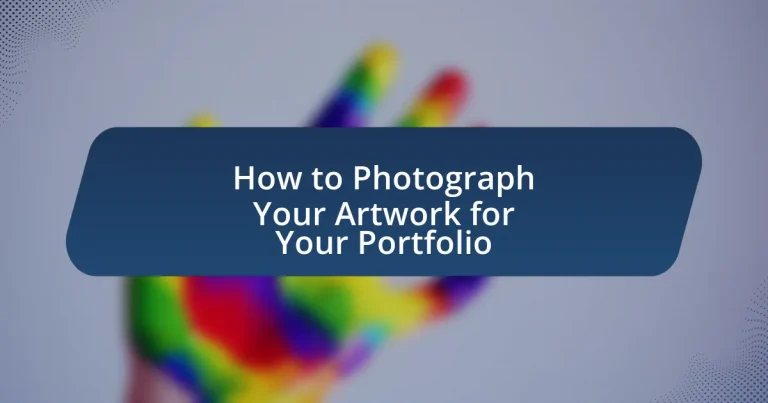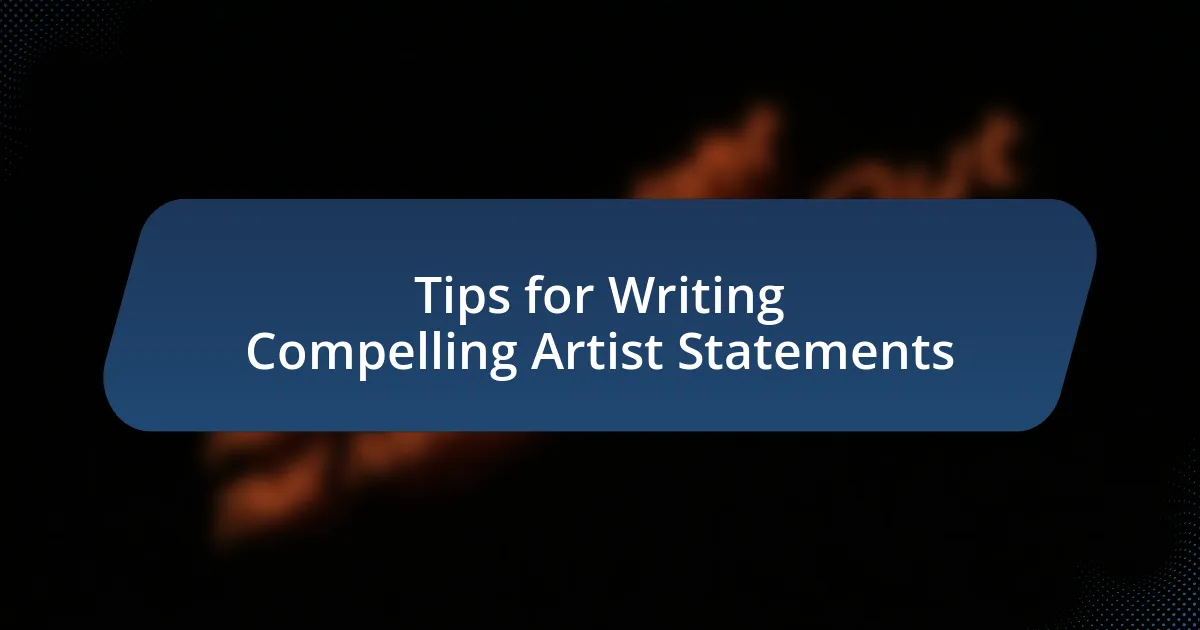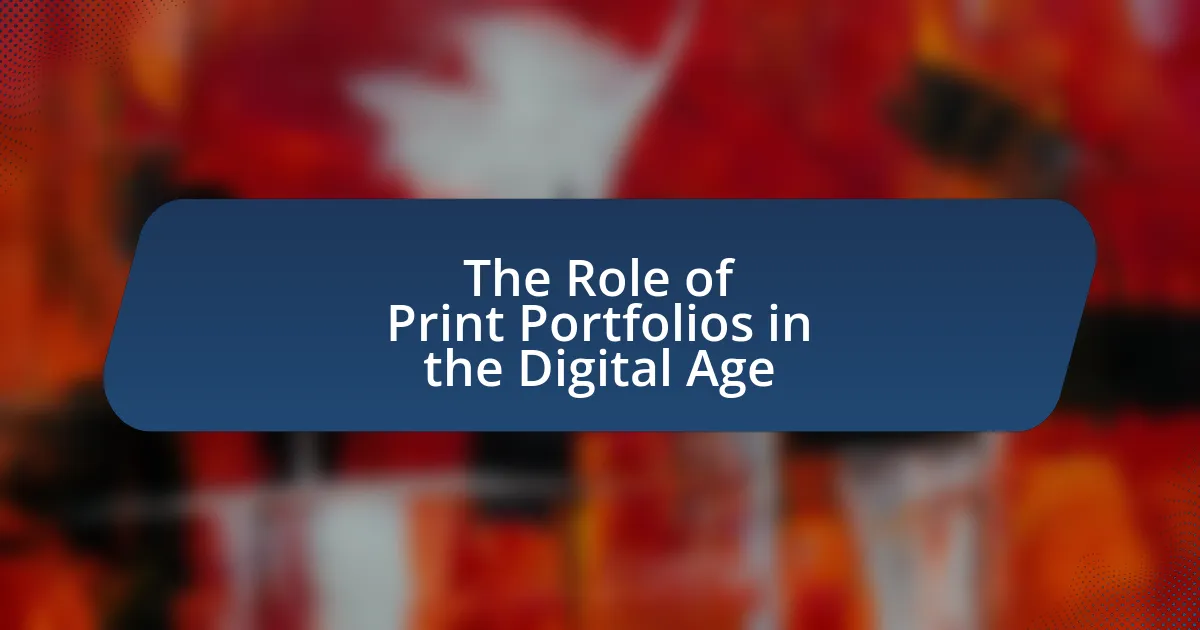The article focuses on the process of photographing artwork for a professional portfolio, emphasizing the importance of high-quality images. Key steps include selecting appropriate lighting, stabilizing the camera with a tripod, and ensuring the artwork is clean and well-positioned. It discusses essential materials needed, such as a high-quality camera and neutral backgrounds, and highlights techniques for optimal results, including camera settings and post-processing adjustments. Additionally, the article addresses common mistakes to avoid, the significance of background choices, and best practices for maintaining consistency and quality across portfolio images.
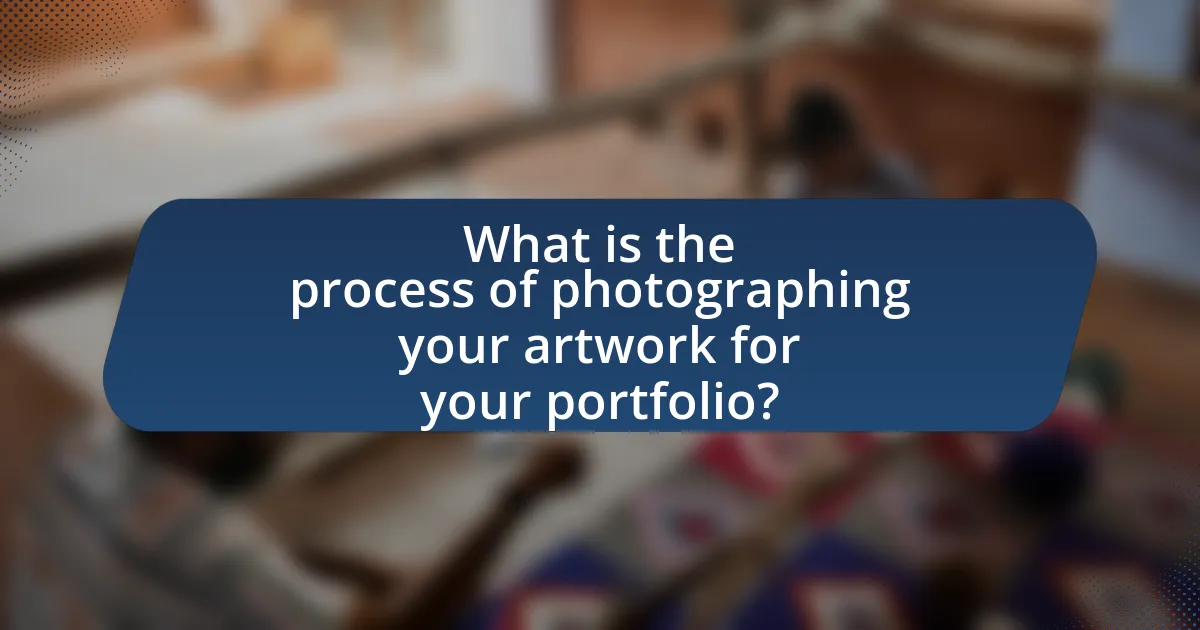
What is the process of photographing your artwork for your portfolio?
The process of photographing your artwork for your portfolio involves several key steps to ensure high-quality images. First, select a well-lit area, preferably with natural light, to minimize shadows and enhance colors. Next, set up your artwork on a flat surface or hang it on a wall, ensuring it is straight and centered in the frame. Use a tripod to stabilize your camera or smartphone, which helps avoid blurriness. Adjust the camera settings for optimal exposure and focus, capturing multiple angles and details of the artwork. Finally, edit the images using software to adjust brightness, contrast, and color accuracy, ensuring the final photos represent the artwork faithfully. This method is supported by photography best practices, which emphasize the importance of lighting, stability, and post-processing for achieving professional results.
How can you prepare your artwork for photography?
To prepare your artwork for photography, ensure it is clean, well-lit, and properly positioned. Cleaning the artwork removes dust and smudges that can affect image quality. Use natural light or a softbox to illuminate the piece evenly, avoiding harsh shadows and glare. Position the artwork at eye level and ensure it is straight and centered in the frame. This setup enhances the visual appeal and accuracy of the photograph, making it suitable for a portfolio. Proper preparation leads to high-quality images that accurately represent the artwork, which is essential for showcasing in a professional portfolio.
What materials do you need to effectively photograph your artwork?
To effectively photograph your artwork, you need a high-quality camera, a tripod, proper lighting, and a neutral background. A high-quality camera, such as a DSLR or mirrorless camera, captures fine details and colors accurately, which is essential for showcasing artwork. A tripod stabilizes the camera, preventing blurriness from hand movement during the shot. Proper lighting, ideally soft and diffused, minimizes shadows and highlights the artwork’s features; natural light or softbox lights are commonly used. A neutral background, such as white or gray, ensures that the focus remains on the artwork without distractions. These materials collectively enhance the quality of the photographs, making them suitable for a professional portfolio.
How does the condition of your artwork affect the photography process?
The condition of your artwork significantly impacts the photography process by influencing the quality of the final images. If the artwork is damaged, such as having scratches, creases, or discoloration, these imperfections will be captured in the photographs, detracting from the overall presentation. For instance, a study by the American Institute for Conservation highlights that artworks in pristine condition yield clearer and more vibrant photographs, which are essential for portfolio quality. Therefore, maintaining the artwork in excellent condition is crucial for achieving high-quality photographic results.
What are the essential techniques for photographing artwork?
The essential techniques for photographing artwork include using proper lighting, maintaining a flat perspective, and ensuring high resolution. Proper lighting, such as natural light or diffused artificial light, minimizes glare and shadows, which can distort the artwork’s true colors and details. Maintaining a flat perspective involves positioning the camera parallel to the artwork to avoid distortion and ensure accurate representation. High resolution is crucial for capturing fine details, allowing for clear reproduction in portfolios or prints. These techniques are supported by photography best practices, which emphasize the importance of clarity and accuracy in visual representation.
How does lighting impact the quality of your artwork photographs?
Lighting significantly impacts the quality of artwork photographs by influencing color accuracy, detail visibility, and overall composition. Proper lighting enhances the vibrancy of colors and reduces shadows that can obscure details, ensuring that the artwork is represented as intended. For instance, natural light provides a broad spectrum that can reveal subtle hues, while artificial lighting can create harsh contrasts if not managed correctly. Studies show that photographs taken in diffused natural light can improve color fidelity by up to 30% compared to those taken under direct artificial light. Therefore, understanding and utilizing appropriate lighting techniques is essential for capturing high-quality images of artwork.
What camera settings should you use for optimal results?
For optimal results when photographing artwork, use a low ISO setting (100-200) to minimize noise, an aperture of f/8 to f/11 for sharpness and depth of field, and a shutter speed that compensates for lighting conditions, typically around 1/60 to 1/125 seconds. These settings ensure high-quality images with accurate color representation and detail. Low ISO reduces grain, while a mid-range aperture provides clarity across the artwork. Adjusting shutter speed according to light conditions prevents motion blur, ensuring the artwork is captured crisply.
Why is the background important in artwork photography?
The background is important in artwork photography because it influences the viewer’s perception and focus on the artwork. A well-chosen background can enhance the artwork’s colors, textures, and overall aesthetic, making it more visually appealing. For instance, a neutral background can prevent distractions and allow the artwork to stand out, while a complementary background can create harmony and context. Research indicates that backgrounds significantly affect visual attention; a study published in the Journal of Vision found that backgrounds can alter the perceived quality of the main subject, demonstrating their critical role in effective artwork presentation.
What types of backgrounds work best for different art styles?
Different art styles benefit from specific types of backgrounds that enhance their visual impact. For example, minimalist art often works best with solid, neutral backgrounds to emphasize simplicity, while vibrant abstract pieces thrive against contrasting, textured backgrounds that add depth. Realistic paintings typically require backgrounds that mimic natural settings or neutral tones to maintain focus on the subject. In contrast, pop art can be effectively showcased on bright, bold backgrounds that reflect its energetic nature. These background choices are supported by the principle that the right context can amplify the artwork’s message and aesthetic appeal.
How can you create a distraction-free environment for your photographs?
To create a distraction-free environment for your photographs, eliminate any clutter and distractions from the background and surrounding area. This can be achieved by selecting a simple, neutral backdrop that does not compete with the artwork, ensuring that lighting is controlled and consistent, and minimizing noise and movement in the vicinity. Research indicates that a clean and organized space enhances focus and improves the quality of visual output, as distractions can divert attention and detract from the subject being photographed.

What common mistakes should you avoid when photographing your artwork?
When photographing your artwork, avoid poor lighting, which can distort colors and details. Natural light is ideal, as it provides even illumination and true color representation. Additionally, avoid using a cluttered background that distracts from the artwork; a simple, neutral backdrop enhances focus on the piece. Another mistake is not using a tripod, which can lead to blurry images due to camera shake; stability is crucial for sharpness. Lastly, neglecting to edit images for color correction and cropping can result in unprofessional-looking photographs; post-processing is essential for presenting artwork accurately.
How can improper lighting affect your artwork photos?
Improper lighting can significantly distort the appearance of artwork photos by altering colors, creating unwanted shadows, and reducing detail visibility. For instance, harsh lighting can wash out colors, making them appear flat and unappealing, while insufficient lighting can lead to dark images that obscure fine details. Studies show that natural light is often the best for capturing true colors, as artificial lighting can introduce color casts that misrepresent the artwork. Therefore, using appropriate lighting techniques is essential for accurately showcasing artwork in photographs.
What are the signs of poor lighting in your photographs?
Signs of poor lighting in photographs include harsh shadows, overexposed highlights, and lack of detail in both dark and light areas. Harsh shadows can create unflattering contrasts that obscure the subject, while overexposed highlights can wash out important details, making the image appear flat. Additionally, if the photograph lacks detail in both the dark and light areas, it indicates that the lighting is not balanced, resulting in a loss of depth and texture. These issues can detract from the overall quality of artwork photography, making it essential to ensure proper lighting for optimal results.
How can you correct lighting issues in post-processing?
To correct lighting issues in post-processing, utilize software tools like Adobe Lightroom or Photoshop to adjust exposure, contrast, and brightness. These adjustments allow for fine-tuning of the image’s light levels, ensuring that details are visible and colors appear accurate. For instance, increasing the exposure can brighten an underexposed image, while adjusting contrast can enhance the distinction between light and dark areas, improving overall image quality. Additionally, using the histogram feature in these programs helps identify areas that may be overexposed or underexposed, guiding necessary corrections.
What are the pitfalls of using the wrong camera settings?
Using the wrong camera settings can lead to poor image quality, resulting in underexposed or overexposed photographs that fail to accurately represent the artwork. Incorrect settings such as ISO, aperture, and shutter speed can cause images to appear grainy, blurred, or lacking in detail. For instance, a high ISO setting in low light can introduce noise, while a slow shutter speed without stabilization can lead to motion blur. These technical flaws diminish the visual appeal of the artwork and may misrepresent colors and textures, ultimately affecting the viewer’s perception and the artwork’s marketability.
How do different resolutions affect the quality of your portfolio?
Different resolutions significantly impact the quality of your portfolio by determining the clarity and detail of the images presented. High-resolution images capture finer details and textures, making artwork appear more vibrant and professional, which is crucial for attracting potential clients or galleries. Conversely, low-resolution images can result in pixelation and a lack of detail, diminishing the perceived quality of the artwork. Research indicates that images with a resolution of at least 300 DPI (dots per inch) are optimal for print portfolios, ensuring that the artwork is displayed with the highest fidelity. This standard is supported by industry practices, where high-resolution images are essential for maintaining the integrity of the artwork in both digital and print formats.
What settings should you avoid to prevent common photography errors?
To prevent common photography errors, avoid using automatic settings on your camera. Automatic settings can lead to inconsistent exposure, focus issues, and poor color accuracy, which are detrimental when photographing artwork. For instance, relying on auto white balance may result in color casts that misrepresent the original piece. Additionally, avoid using high ISO settings, as they introduce noise that can obscure fine details in the artwork. Instead, use manual settings to control exposure, aperture, and ISO for optimal results.
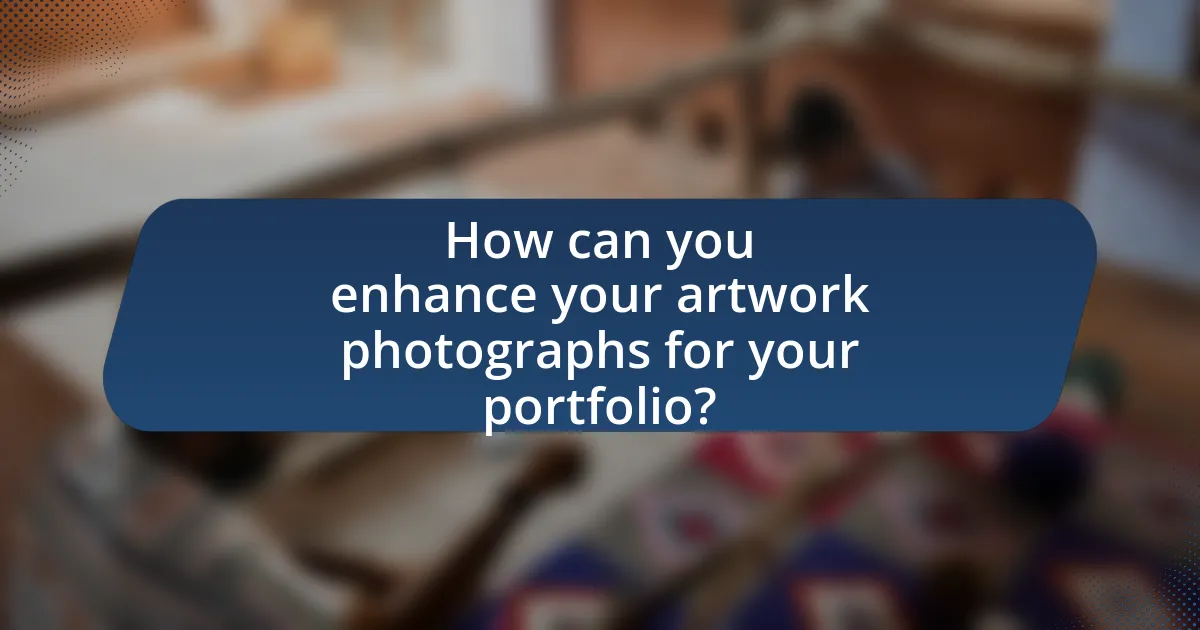
How can you enhance your artwork photographs for your portfolio?
To enhance your artwork photographs for your portfolio, utilize proper lighting, high-resolution cameras, and post-processing techniques. Proper lighting, such as natural light or soft diffused artificial light, minimizes shadows and highlights details, ensuring the artwork is accurately represented. High-resolution cameras capture intricate details and colors, which is crucial for showcasing the quality of the artwork. Post-processing techniques, including color correction and cropping, refine the images, making them more visually appealing and professional. Studies show that well-lit and high-quality images significantly increase viewer engagement and interest in artwork, validating the importance of these enhancements.
What editing techniques can improve your artwork images?
Editing techniques that can improve your artwork images include adjusting brightness and contrast, enhancing color saturation, cropping for better composition, and applying sharpening filters. Brightness and contrast adjustments help to highlight details and create depth, while enhancing color saturation makes the artwork more vibrant and appealing. Cropping can eliminate distractions and focus attention on the artwork, and sharpening filters can enhance clarity and detail, making the image more visually striking. These techniques are widely used in digital photography and art presentation, as they significantly enhance the overall quality and impact of the images.
How can cropping and straightening enhance the composition?
Cropping and straightening enhance composition by improving focus and balance in the image. Cropping removes unnecessary elements, directing the viewer’s attention to the artwork itself, which can lead to a more impactful presentation. Straightening corrects any tilts, ensuring that the artwork is displayed accurately, which is crucial for maintaining the integrity of the piece. Research indicates that well-composed images can increase viewer engagement by up to 50%, highlighting the importance of these techniques in photography.
What adjustments can you make to color and contrast for better visuals?
To enhance visuals in photography, adjust color saturation and contrast levels. Increasing color saturation makes hues more vivid, while adjusting contrast enhances the difference between light and dark areas, resulting in a more dynamic image. Research indicates that images with higher contrast are perceived as more engaging, as they draw the viewer’s attention effectively. For instance, a study published in the Journal of Vision found that images with optimal contrast levels improve viewer retention and emotional response.
How can you present your artwork photographs effectively in your portfolio?
To present your artwork photographs effectively in your portfolio, ensure high-quality images that accurately represent the colors and details of the artwork. Use natural lighting or professional lighting setups to avoid glare and shadows, which can distort the appearance of the artwork. Additionally, maintain a consistent style in framing and background to create a cohesive look throughout the portfolio. Research indicates that portfolios with uniform presentation styles are perceived as more professional and engaging, enhancing viewer retention and interest.
What layout options are best for showcasing your artwork?
Grid layout options are best for showcasing your artwork, as they provide a structured and organized presentation that enhances visual appeal. This layout allows for multiple pieces to be displayed simultaneously, creating a cohesive look that draws the viewer’s eye across the collection. Research indicates that grid layouts can improve viewer engagement by up to 30%, as they facilitate easier navigation and comparison among artworks. Additionally, using a consistent spacing and alignment within the grid can further enhance the overall aesthetic, making the artwork stand out more effectively.
How can you use captions and descriptions to enhance viewer engagement?
Captions and descriptions can enhance viewer engagement by providing context and storytelling elements that draw the audience into the artwork. When captions succinctly explain the inspiration, technique, or emotion behind a piece, they create a deeper connection between the viewer and the artwork. Research indicates that visual content paired with descriptive text increases retention and understanding, as evidenced by a study from the University of California, which found that people remember 65% of information when it is combined with relevant visuals compared to only 10% when presented alone. Therefore, effective use of captions and descriptions not only informs but also captivates the audience, leading to increased interaction and appreciation of the artwork.
What are some best practices for photographing your artwork?
To photograph your artwork effectively, use natural light, a tripod, and a neutral background. Natural light minimizes shadows and highlights the true colors of the artwork, while a tripod ensures stability and sharpness in the image. A neutral background prevents distractions and allows the artwork to stand out. Additionally, shoot at a high resolution to capture fine details, and consider using a color calibration tool to ensure accurate color representation. These practices enhance the quality of the photographs, making them suitable for a professional portfolio.
How can you ensure consistency across your portfolio photographs?
To ensure consistency across your portfolio photographs, maintain uniform lighting, color balance, and composition throughout all images. Consistent lighting, such as using the same type of natural or artificial light, prevents variations in shadows and highlights, which can distract from the artwork. Additionally, using a calibrated camera and consistent white balance settings helps achieve uniform color representation. Finally, adhering to a similar composition style, such as framing and background choices, reinforces a cohesive look across the portfolio. This approach is supported by photography best practices, which emphasize the importance of these elements in creating a professional and unified presentation of artwork.
What tips can help you maintain high-quality images throughout your portfolio?
To maintain high-quality images throughout your portfolio, ensure consistent lighting and use a high-resolution camera. Consistent lighting minimizes shadows and highlights, which can distort the artwork’s true colors and details. A high-resolution camera captures intricate details, allowing for better reproduction of the artwork. Additionally, using a tripod stabilizes the camera, reducing blurriness, while editing software can enhance image quality by adjusting exposure and color balance. Research indicates that images taken in natural light often yield the best results, as they provide a balanced color spectrum, further supporting the importance of lighting in photography.
